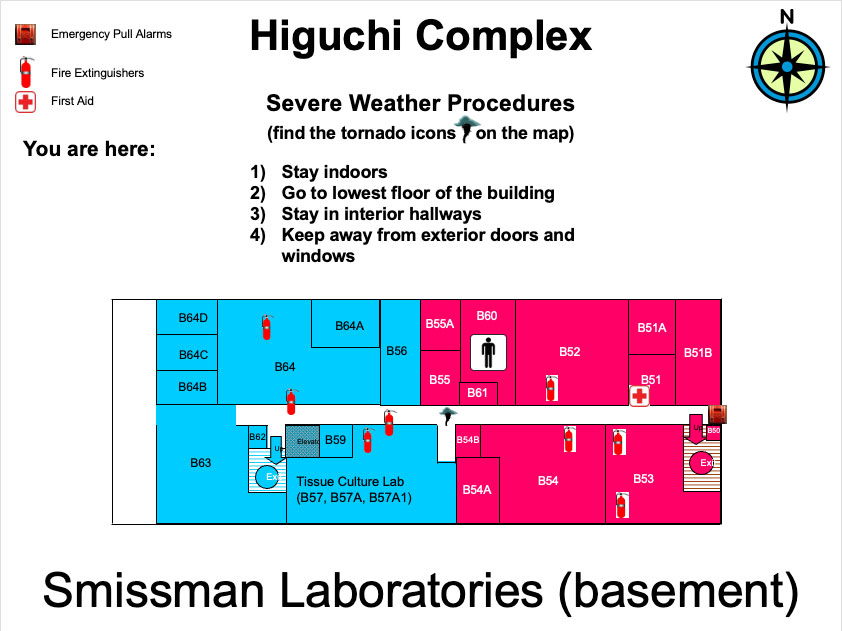Lab Safety Presentation 2021-22
On This Page
- Security
- Emergency Procedures for the Higuchi Complex
- General Emergency Procedures
- Important Phone Numbers
- Spill Kit Inventory
- In the Event of a Spill
- Fire/Tornado Emergency Procedures
- HBC Building Emergency Evacuation Plan
- General Evacuation Procedures
- Emergency Evacuation for Persons with Disabilities
- HBC Emergency Preparedness Team
- Evacuation and Severe Weather/Tornado Drills
- Safety Apps
- KU COVID-19
- Higuchi Complex - Simons Lab Maps
- Higuchi Complex - McCollum Lab Maps
- Higuchi Complex - Smissman Lab Maps
Security
- Outside entrances are unlocked at 8 AM and relocked at 5 PM.
- Please contact André Faucher or Christian Schöneich if you notice the building unlocked.
- C-BORD – Carry your KU ID with you at all times! Required for designated entrance and all lab access.
- Keys – On Request
- No door propping or lock stuffing!
- Dial 911 to get help if you see intruders –don’t approach them!
- Use a campus phone if possible
- If you use a cell phone, you may get connected to a different police dispatch center, so always tell the dispatcher what city you are in. The dispatcher will contact the correct dispatch center and relay the information for you.
Emergency Procedures for the Higuchi Complex
(adapted from information provided by KU Environment, Health and Safety (EHS) on KU Lawrence and Edwards Campus Alerts)
- Civil disturbance
- Flooding
- Gas leak, fumes, vapors
- Active shooter, Active threat
- Suspicious package
- Hazardous materials
- Power outage
- Suicide threat
- Fire/smoke
- Medical emergencies
- Bomb threat
- Tornado and inclement weather
General Emergency Procedures
- Contact Kansas University Police Department (911) immediately (if there is a spill /release of hazardous chemicals, biological, or radioactive materials, contact EHS at 785-864-4089).
- Take any quick, obvious and low risk actions that would minimize the consequences of the emergency:
- If there is a small fire, use a nearby extinguisher to control and extinguish it. Do not use a fire extinguisher unless you have been trained to do so. Improper use of an extinguisher can increase the hazard. If the initial extinguishing attempt does not succeed, evacuate the area. Do not go after more extinguishers or back into the fire area. Do not attempt to fight fires that are large, are out of control, or may be in the presence of a toxic atmosphere.
- If there has been an emergency-level spill/release of hazardous material and the spill does not present immediate personal danger, turn off or remove any heat sources, try to control the spread or the volume of the spilled material by absorbents or containment, and pull sashes to close fume hoods. Do not operate electrical switches except to de-energize if flammable vapors are present. If the spilled substance is an unknown, evacuate the area, closing doors to isolate the spill and secure the area. Do not attempt to clean up a spill/release unless you are trained to do so and have the proper equipment.
- If it is safe to do so, log off computers, shut off non-essential electrical equipment, and secure vital equipment, hazardous materials, and sensitive files.
- If there is immediate danger, evacuate the area (in case of fire, crawl on your knees to the closest safe exit, breathing through your nose, using a shirt or towel as a filter).
- Notify individuals in immediate and adjacent areas about the situation and associated hazards.
- If the emergency presents a danger to other building occupants, activate the building alarm and evacuate immediately.
- If the building alarm is activated, evacuate by the nearest safe emergency exit (map on reverse).
EXCEPTION: if a tornado warning is announced, take the following immediate precautions:
- Move immediately to a pre-designated shelter area (see map on reverse). If you cannot reach a pre- designated shelter area, go to the center of an interior room (closet or interior hallway) on the lowest level, away from corners, windows, doors, and outside walls.
- Put as many walls as you can between you and the outside. If possible, get under a sturdy table or piece of furniture, and always protect your head and neck with your arms.
- Remain there until the all clear is given by local radio stations, police, or other official sources of information. In university buildings equipped with voice emergency warning systems, an all-clear message will be activated when an official all-clear has been issued for Lawrence.
- As you evacuate, close doors and windows behind you, and do not use elevators.
- If you are trapped in the building, close all doors and windows in the room and use cloth material (wet, if possible) to block smoke and noxious fumes from coming around and under the doors.
- If it can be done without endangering yourself, provide assistance to those who may need it.
- Only assist an injured person if you are properly trained to administer first aid; otherwise, keep the injured person still and calm, keep unnecessary individuals away, and do not move the injured person unless it is necessary to prevent his/her exposure to further harm. University employees (anyone, including students, who receives a bi-weekly paycheck) must go to Lawrence Memorial Hospital for on-the-job injuries requiring medical treatment. Students who are not University employees (those who are paid by monthly stipend or receive no compensation) should go to Watkins Health Center. .
- Protect yourself and others from blood/body fluids and any hazards that could cause injury.
- If the emergency is contained within a single lab, assemble in a designated safe area.
- If evacuating to the outside, assemble at a safe location upwind from the facility.
- Once in a safe location, all individuals must remain until released; no one may re-enter the building without the permission of KUPD.
- If you reported the incident or have specific knowledge of the incident, immediately report to the Emergency Services Field Command Post (first responding KUPD officer).
- Assist in making sure that all personnel, students and visitors are accounted for.
- Segregate individuals who have been contaminated with Hazardous Materials.
Important Phone Numbers
- KU Environment, Health and Safety (EHS) General - 785-864-4089
- KU Environment, Health and Safety (EHS) HazMat - 785-864-2853
- KU Public Safety - 785-864-5900
- Emergency - 911
More info at KU Environment, Health and Safety
 Spill Kit Inventory and Instructions
Spill Kit Inventory and Instructions
Your spill kit should consist of:
- 1 five gallon screw-top bucket
- 1 48" mini-boom (the long, skinny sorbent)
- 2 sorbent pads
- 2 trash bags
- 2 pairs of nitrile gloves
If any items are missing or have been used, contact KU Environment, Health and Safety (EHS) to have them replenished.
In the Event of a Spill
- Remain calm, move away from the spill, and ask other lab personnel for help.
- If anyone has been injured, remove them and any personnel who may be affected from the area.
- If necessary, get them to the eyewash or safety shower and call 911.
- Is there an immediate threat to life or health? If so, clear the area.
- Pull fire alarm to evacuate building and call 911
- Call EHS Hazmat line at 785-864-2853 or EHS General line at 785-864-4089
- Report to responding emergency personnel (Police, Fire, EHS)
- If the spill generates flammable vapor, extinguish possible ignition sources if safe to do so.
- Do not open windows as this may draw fumes further into the building.
- Consult the Material Safety Data Sheet (MSDS) for guidance.
Can You Clean the Spill?
Do you have sufficient:
- Equipment to protect you from the hazards of the spill?
- Materials and absorbents to clean the spill?
- Training to make the above determinations?
- Training to clean the spill safely?
If you answered "no" to any of the above questions, do not attempt to clean the spill without seeking assistance from EHS.
- Call EHS Hazmat line at 785-864-2853 or EHS General line at 785-864-4089
- If possible, use items in the spill kit to prevent the spill from spreading or reaching floor drains before EHS arrives.
Spill Response Guidelines
| Guideline | Image |
|---|---|
| Liquid chemical spill. Put on appropriate personal protective equipment (PPE). | 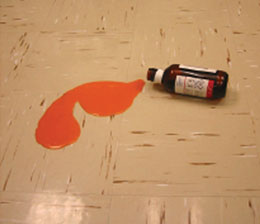 |
| Use the mini-boom to block the spill from spreading under furniture or into floor drains. | 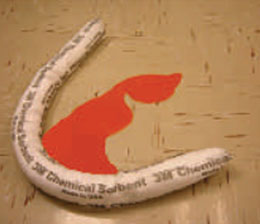 |
| Place sorbent pillows on top of spill to absorb the chemical. | 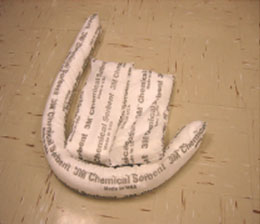 |
| Wipe up the spill area with remaining sorbent pads. | 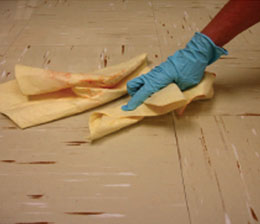 |
| Line the 5-gallon bucket with the trash bag and put all of the used clean-up material inside. | 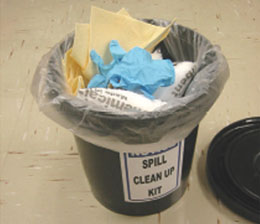 |
| Close the trash bag and the bucket. Attach a completed Hazardous Materials label and contact EHS for pickup and replacement. | 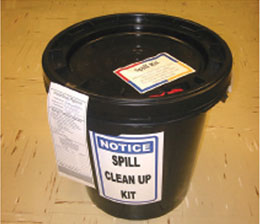 |
Fire/Tornado Emergency Procedures
Fire
- SECURE dangerous substances in a fume hood
- CLOSE fume hood (pull sashes)
- PULL the nearest building alarm in not sounded
- ASSIST others in leaving the immediate area
- LEAVE the building (use exits shown on map)
- DO NOT use the elevators
- GO to a safe location upwind from the facility
Tornado
- MOVE to the nearest tornado shelter area (see maps below)
- Simons - McCollum basement
- McCollum - basement hallway
- Smissman - basement hallway
- STAY where you are until the all clear is given
HBC Building Emergency Evacuation Plan
Printed copies of the Building Emergency Evacuation Plans for the HBC Complex have been placed in the following locations:
- Simons Reception Area (Simons 101)
- Pharm Chem Upstairs Lounge – (Williams/Helm Interaction Area in 2nd-floor of Simons)
- Western Staircase – 2nd Floor
- Pharm Chem Office (Simons 182)
- HBC Breakroom (McCollum 107)
General Evacuation Procedure
- Immediately obey evacuation alarms and orders to evacuate. Tell others to evacuate.
- No one may remain inside a building when an evacuation is initiated.
- Classes in session must evacuate.
- If involved with hazardous research or doing a dangerous procedure, immediately shut down operations that could create additional hazards if left unattended. Evacuate as soon as possible.
- Close windows and doors as rooms are vacated.
- Proceed calmly but quickly to the nearest emergency exit.
- Use stairways to evacuate, if able to do so.
- Follow the evacuation route directly to your designated Emergency Assembly Area(s) located at the east side of the complex (parking lot parallel to Iowa) unless a member of the emergency evacuation team meets you at the exit to re-direct you to another location. Once in the assembly area, go toward the north or south depending on the wind direction and location of the emergency. If there is smoke or noxious/toxic fumes, walk into the wind. Supervisors/managers are responsible for taking roll call.
- Do not reenter the building until authorized KU Public Safety, University Fire Marshal or Lawrence Douglas County Fire and Medical personnel give the “All Clear” instruction. In the event that the building cannot be occupied for an extended period of time, additional direction will be provided by University administration.
Emergency Evacuation for Persons with Disabilities
University procedures require all persons, including those with disabilities, to evacuate the facility when the fire alarm is activated or when otherwise instructed to do so. In the event of evacuation, the following evacuation options should be considered in conjunction with the disabled individual’s personal action plan, if any.
Persons needing assistance in an emergency, including those with disabilities, are encouraged to develop personal action plans and identify their primary and secondary evacuation routes. This includes, if necessary, identifying at least two (2) individuals who are willing to serve as evacuation assistants in the event of an evacuation, as described in the University’s Building Emergency Evacuation Plan. Copies of the personal action plans will be shared with the University’s Building Emergency Liaison and others as necessary to provide for alerting, evacuation or sheltering during an emergency.
HBC Emergency Preparedness Team
| Name | Department | Phone |
|---|---|---|
| Christian Schöneich | Pharm Chem | 785-864-4880 |
| Teruna Siahaan | Pharm Chem | 785-864-7327 |
| Karen Hall | Pharm Chem | 785-864-4816 |
| Tom Tolbert | Pharm Chem | 785-864-3405 |
| Lanaea Heine | BIO Center | 785-864-5141 |
| John Stobaugh | HBC | 785-864-3996 |
| Paula Hinman | HBC | 785-864-0908 |
| André Faucher | HBC | 785-864-3751 |
Evacuation and Severe Weather/Tornado Drills
- Evacuation & severe weather/tornado drills shall be conducted at least once annually at unexpected times and under varying conditions to simulate the unusual conditions that occur should an evacuation be necessary.
- Drills shall involve all occupants present in the building.
- When the fire alarm sounds, everyone shall leave the building. For severe weather/tornado drills, everyone shall move immediately to the proper sheltered areas.
- In the conduct of drills, emphasis shall be placed upon orderly evacuation under proper discipline rather than upon speed.
Safety Apps
KU Alerts
Sign up for emergency text messages at KU Alerts
Rave Guardian App
Personal Safety app. Get the app at KU Mobile Plaza: Rave Guardian
Wireless Emergency Alerts (WEAs) – Ready.gov
Sign up at Emergency Alerts (ready.gov)
Higuchi Complex
Simons Laboratories
First Floor Map
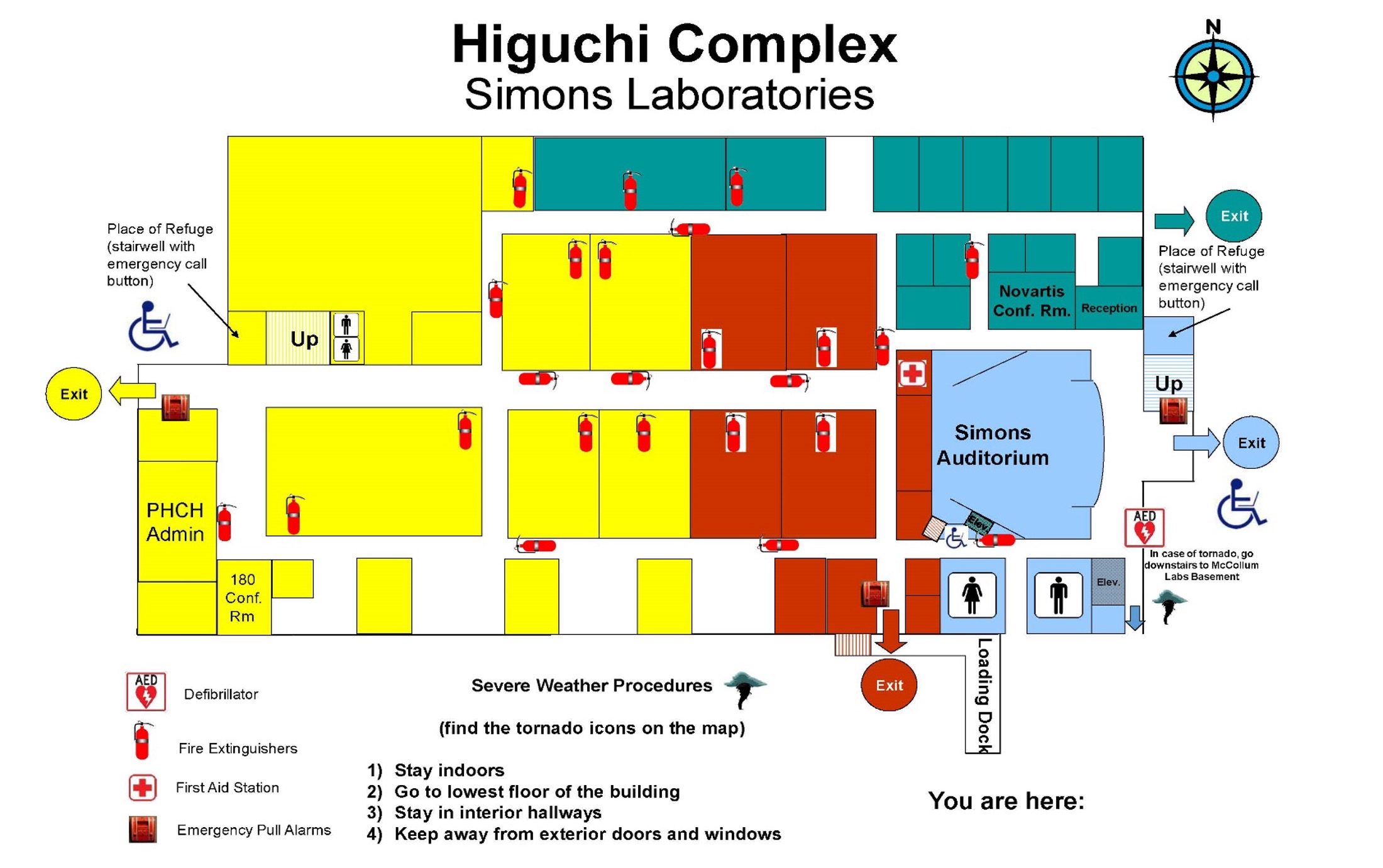
Second Floor Map
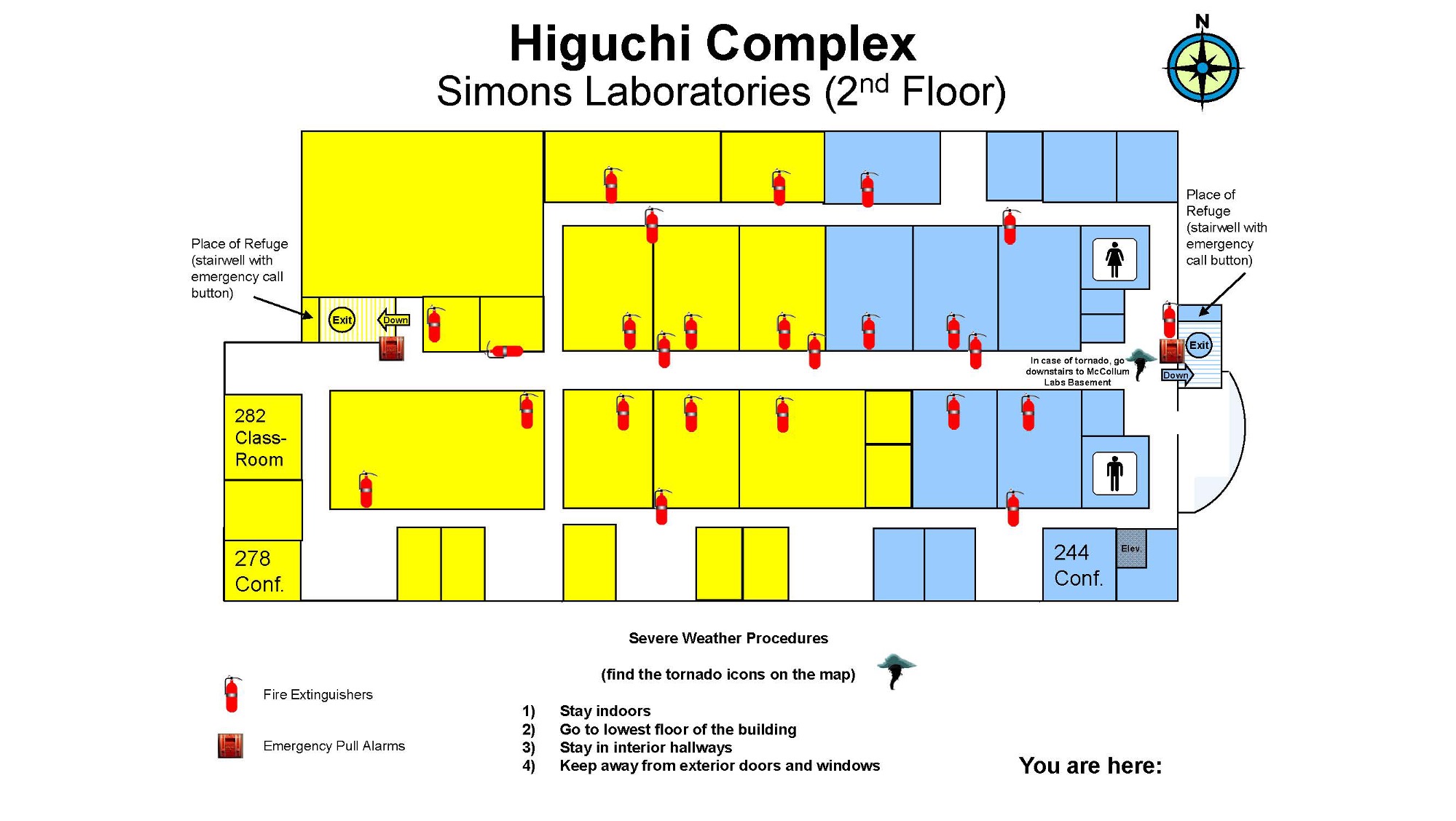
Higuchi Complex McCollum Laboratories
First Floor Map
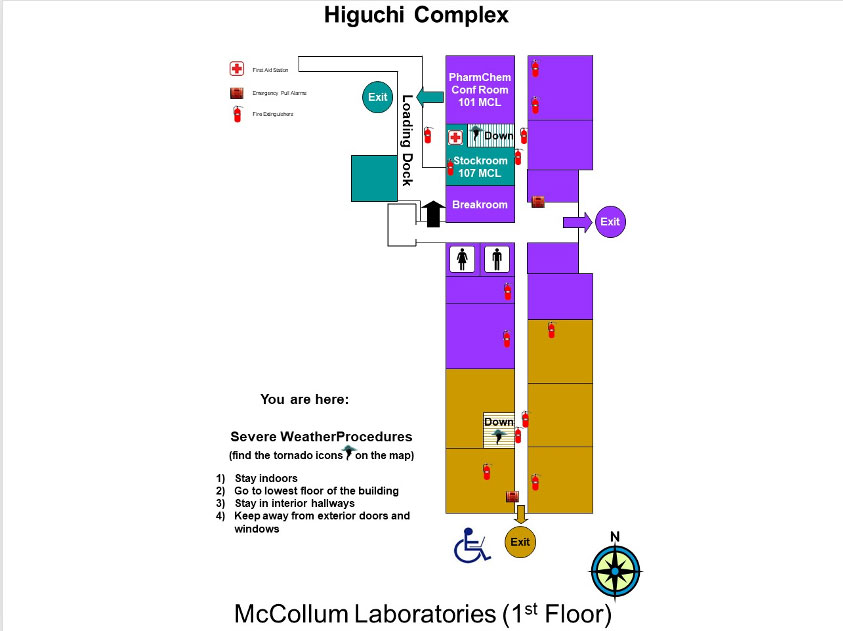
Basement Map
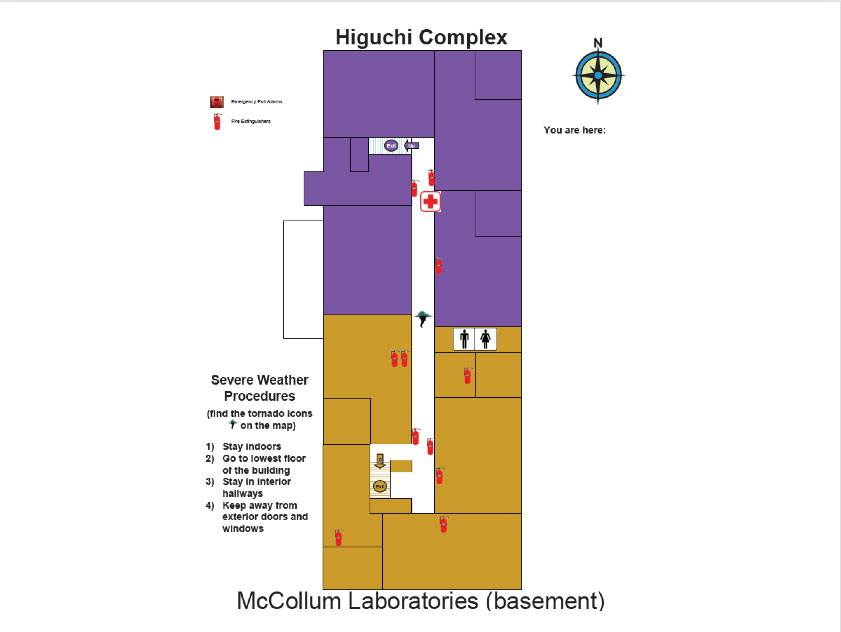
Higuchi Complex Smissman Laboratories
First Floor Map
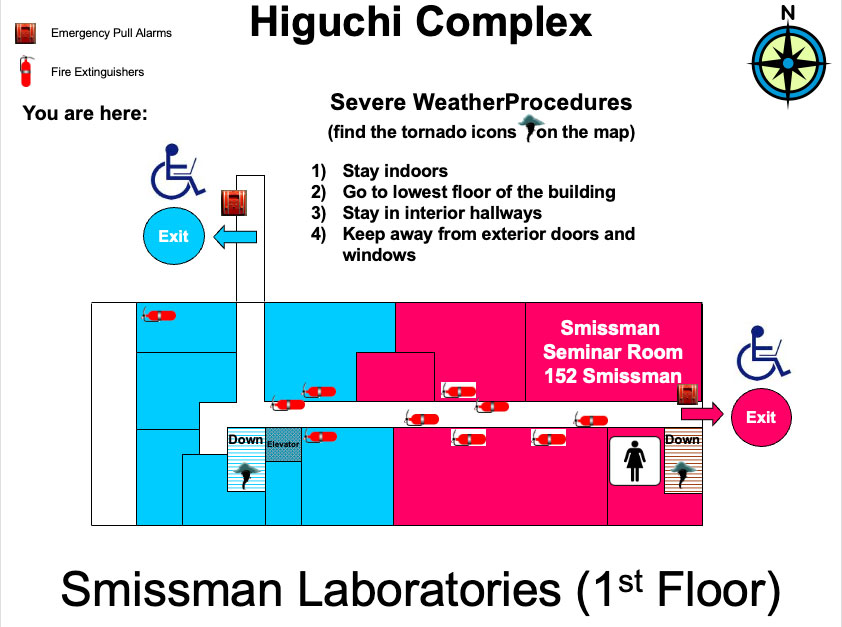
Basement Map
